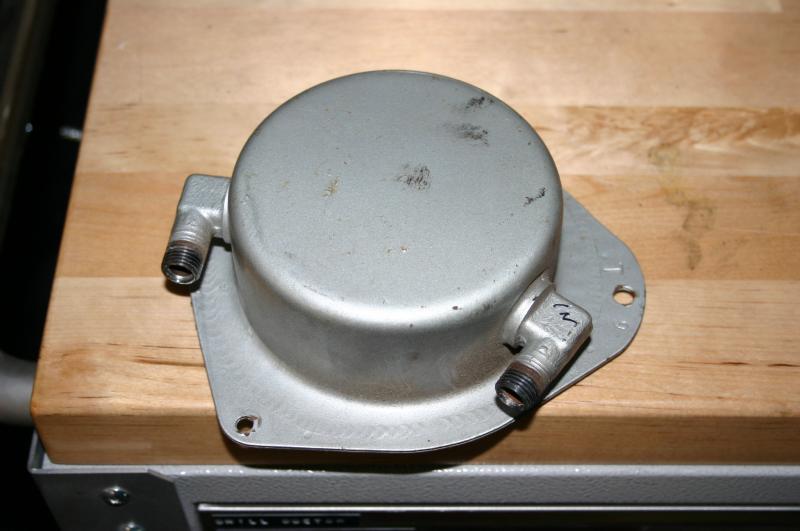So, I'm just finishing up the fuel system in the mutant MGB, and I discovered this thing hiding near one of the taillights.

I'm thinking it's a swirl tank. The return line from the regulator goes into one of the fittings - at the top when it's mounted vertically in the car - and the lower fitting has a line that runs to the tank. The bracket it was hanging on didn't look designed-in, though.
Is this a normal thing? Should I keep it? The car is a 1972 MGB GT, by the way.
Nope, it's not a swirl tank. That's a very old design vapor separator, it's part of the onboard fuel vapor recovery system. The car originally would have had a more conventional looking adsorption canister up front as well.
If you remove it and plug the port, you have just plugged the fuel tank vent. Unless you want your tank to collapse inward, you'll need to provide another venting method. Older MGBs had a vented cap but the fill neck is different, so you'll need both the old style fill neck and cap.
Interesting. I thought it was originally hooked up to a regulator, but it's possible it was attached to something in the engine bay. It's been a few months since that was the case, all I have is some partial hard lines to go off.
I have a 1969 (I think, definitely pre-70) GT parts car. I'll check those parts.
Thanks!
If I remember correctly, it was connected to the under hood charcoal canister.

oldtin
HalfDork
6/8/10 7:16 p.m.
Mine was/is a 72. There was a separate fitting by the filler neck - separate hole in the floor too for the vapor line.

Just to expound, it's actually more of a catch tank for liquid fuel. As mentioned, fuel vapor circulates through the system. The tank does catch the condensed vapor, but primarily prevents raw gas from expanding up from a full tank and blocking the vent line in turn saturating the charcoal canister. Originally that would have been mounted in the trunk on the side. One of those ports would have been connected to the fuel tank via a flex line. The other port would have had a flex line going to to the trunk floor, then to a hard line. The hard line ran parallel to the fuel line and brake lines to the engine compartment and ultimately to a black charcoal canister roughly the size of a peanut butter jar. From there it went to the carbs. The fuel overflow also went to the charcoal canister. This portion of the emissions system, although cluttery, doesn't hurt performance. As mentioned, you can use an earlier vented filler cap or reinstall the expansion tank and vent it to atmosphere.
Long winded and leaning toward anorak territory, I know, but there you have it. FYI, if you do block the vent for the tank, it will be more likely to drool raw gas from the filler cap than to distort the tank.

Per Schroeder
Technical Editor/Advertising Director
6/8/10 7:36 p.m.
Really great thread for classicmotorsports.net (hint)

Thanks for the detailed explanation - it turns out there's a joint in the hard line running towards the front of the car right where it passes by the fuel pump, and I'd taken the line apart there. The various flex lines were still in place.
Because I'm running a radically different fuel system than the original MG one - and I have very little room in the engine bay - I'm going to delete the canister and go back to a 1969 filler/vented cap solution. I'd prefer not to have the filler dribble the way it likes to on my Mini, so if I do find a little bit of extra space when I'm done I'll run a vent line to a charcoal canister taken from a different car. 1999+ Miatas have a nice small one  The one originally out of this MG had suffered an injury at some point in the past and had a nice melted hole from what I recall. The vapour lines shall be hijacked and used as a return line for the fuel injection system.
The one originally out of this MG had suffered an injury at some point in the past and had a nice melted hole from what I recall. The vapour lines shall be hijacked and used as a return line for the fuel injection system.
By the way, those flex lines seem to be braided stainless. Cool. But they have some oddball flare I haven't been able to identify or duplicate yet, so I'm having to be creative in integrating original fittings into my lines. I think I have it worked out now.
In reply to Keith:
Those fuel lines use an oddball flare like you say and many of them are threaded to BSP (British Standard Pipe). You'll also find most of them don't fit normal US or Metric wrenches--you need old fashoned British wrenches for them. Most fuel fittings stayed British and a few brake fitttings did right until 1980.

































